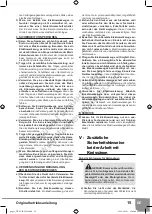
5
Original instructions
EN
away from moving parts. Loose clothes, jewellery
or long hair can be caught in moving parts.
g) If devices are provided for the connection of
dust extraction and collection facilities, ensure
these are connected and properly used. Use of
dust collection can reduce dust-related hazards.
4. POWER TOOL USE AND CARE
a) Do not force the power tool. Use the correct
power tool for your application. The correct power
tool will do the job better and safer at the rate for which
it was designed.
b) Do not use the power tool if the switch does not
turn it on and off. Any power tool that cannot be
controlled with the switch is dangerous and must be
repaired.
c) Disconnect the plug from the power source and/
or the battery pack from the power tool before
making any adjustments, changing accessories,
or storing power tools. Such preventive safety
measures reduce the risk of starting the power tool
accidentally.
d) Store idle power tools out of the reach of chil-
dren and do not allow persons unfamiliar with
the power tool or these instructions to operate
the power tool. Power tools are dangerous in the
hands of untrained users.
e) Maintain power tools. Check for misalignment
or binding of moving parts, breakage of parts
and any other condition that may affect the
power tool’s operation. If damaged, have the
power tool repaired before use. Many accidents
are caused by poorly maintained power tools.
f) Keep cutting tools sharp and clean. Properly
maintained cutting tools with sharp cutting edges are
less likely to bind and are easier to control.
g) Use the power tool, accessories and tool bits
etc. in accordance with these instructions, tak-
ing into account the working conditions and the
work to be performed. Use of the power tool for op-
erations different from those intended could result in a
hazardous situation.
5. SERVICE
a) Have your power tool serviced by a qualified
repair person using only identical replacement
parts. This will ensure that the safety of the power
tool is maintained.
V - Circular saw safety
warnings
Safety instructions for all saws
а)
DANGER:
Keep hands away from cut-
ting area and the blade. Keep your second
hand on auxiliary handle, or motor housing.
If both hands are holding the saw, they cannot be
cut by the blade.
b) Do not reach underneath the workpiece. The
guard cannot protect you from the blade below the
workpiece.
c) Adjust the cutting depth to the thickness of the
workpiece. Less than a full tooth of the blade teeth
should be visible below the workpiece.
d) Never hold piece being cut in your hands or
across your leg. Secure the workpiece to a sta-
ble platform. It is important to support the work
properly to minimize body exposure, blade binding,
or loss of control.
e) Hold the power tool by the insulated gripping
surfaces only, when performing an operation
where the cutting tool may contact hidden wir-
ing or its own cord. Contact with a “live” wire will
also make exposed metal parts of the power tool
“live” and could give the operator an electric shock.
f) When ripping always use a rip fence or straight
edge guide. This improves the accuracy of cut and
reduces the chance of blade binding.
g) Always use blades with correct size and shape
(diamond versus round) of arbour holes.
Blades that do not match the mounting hardware of
the saw will run eccentrically, causing loss of con-
trol.
h) Never use damaged or incorrect blade wash-
ers or bolt. The blade washers and bolt were spe-
cially designed for your saw, for optimum perfor-
mance and safety of operation.
Further safety instructions for all saws
Kickback causes and related warnings
▪
Kickback is a sudden reaction to a pinched, bound or
misaligned saw blade, causing an uncontrolled saw to
lift up and out of the workpiece toward the operator;
▪
When the blade is pinched or bound tightly by the kerf
closing down, the blade stalls and the motor reaction
drives the unit rapidly back toward the operator;
▪
If the blade becomes twisted or misaligned in the cut,
the teeth at the back edge of the blade can dig into the
top surface of the wood causing the blade to climb out
of the kerf and jump back toward the operator.
Kickback is the result of saw misuse and/or incorrect op
-
erating procedures or conditions and can be avoided by
taking proper precautions as given below.
a) Maintain a firm grip with both hands on the
saw and position your arms to resist kickback
forces. Position your body to either side of the
blade, but not in line with the blade. Kickback
could cause the saw to jump backwards, but kick-
back forces can be controlled by the operator, if
proper precautions are taken.
b) When blade is binding, or when interrupting
a cut for any reason, release the trigger and
hold the saw motionless in the material until
the blade comes to a complete stop. Never at-
tempt to remove the saw from the work or pull
the saw backward while the blade is in motion
or kickback may occur. Investigate and take cor-
rective actions to eliminate the cause of blade bind-
ing.
c) When restarting a saw in the workpiece, centre
the saw blade in the kerf and check that saw
teeth are not engaged into the material. If saw
pages_TK 65-85-2012.indd 5
22.11.2012 г. 11:41:43 ч.
Та
ше
в
-
Га
лв
ин
г
ОО
Д
www.tashev-galving.com








































